
Interior
The latched side panels and push-clip mesh sections make accessing the Graphite 780T as easy as is realistically possible. The plastic surroundings can also be removed, as they're held in place with screws, but really there's no need to do so unless you're planning a paint job, as all hardware can be installed without doing so. The only bit that is remotely fiddly is reaching through the optical drive cage to release the bay covers, but even this take just a few seconds.With the panels off, the black steel interior is revealed. The paint job is top notch and the build quality is again high. Furthermore, virtually all of the little finishing touches we like to see are found inside, including rubber feet for the PSU to sit on, black sleeved internal cables and pre-installed motherboard mounts, including an extended one in the middle to hold your board in place vertically while you reach for the screws. There's also loads of clearance for CPU coolers, graphics cards and the PSU, so extreme systems are well catered for.
The cables are pre-routed but not to the degree that they are in Phanteks cases. Nonetheless, cable management is very easy. Behind the motherboard tray is very spacious, and there's a particularly useful area along the bottom where you can tuck lots of cables. The biggest routing hole is found next to the PSU. It doesn't have a grommet, but the remaining holes dotted in useful positions around the motherboard tray do. Sadly, these grommets aren't as secure as they should be – more than once they came off, so be sure to thread cables through carefully unless you want the tedious job of refitting grommets to deal with.
2.5-inch drives can be installed tool-free in one of the three vertically stacked mounts to the right of the main drive cages – the same design found in the Obsidian 750D and Graphite 760T. We're big fans of these – they hold drives securely, are very well placed for cable management and make good use of an area that's typically something of a dead zone.
Corsair also includes two three-bay drive cages for 3.5-inch and 2.5-inch drives. The cages are modular and slide in and out along rails, and there's also room to stack a third cage (sold separately), so the storage options are extensive. Each cage is secured using three regular screws – it's odd that thumbscrews aren't used given the tool free nature of the chassis elsewhere. The third screw is irksome, as you can only access it behind the front fans. For one cage, we only had to wiggle our screwdriver through the fan blades, but for the other we had to fully remove the fan, as its bracket partially blocked the screw. We understand the need to secure the cages to the chassis, but even so this is a stupid and unnecessary design flaw. The modular rails could also use some work, as the cages were often very stiff to get in and out.
The actual drive trays themselves are also a bit of a let-down, as they're very flimsy. Of course, they do need to have some flexibility so they can bend around and lock in place 3.5-inch drives with the rubberised pins, but Corsair has overdone it, as they're not rigid enough to hold themselves securely in the drive cage without a HDD inside them pushing against the sides, so using a 2.5-inch could see them come out of place if you move the case.
Impressively, both the roof and front panels can house 360mm or 280mm radiators. The top section of the roof (right beneath the filter) can host a single row of fans, while beneath it there is room for a slimline radiator with another row of fans for push-pull, or a thick radiator by itself. You can also use 240mm radiators here without worrying about conflict with any optical drives. As for the front, then provided you remove the HDD cages, the depth of your set-up is only really limited by the length of your graphics card. Hanging a single HDD cage form the optical drive cage would allow you to use a 240mm radiator beneath, but if you want to use a 280mm or 360mm radiator here you can also reposition the lowest HDD cage further into the chassis. In this case, the depth behind the front fans is about 85mm by our measurement. This should just be enough for a thick radiator with another set of fans, though we can't guarantee it – using a slimmer radiator or slim model fans, however, would be fine.
The final position for radiators larger than 140mm/120mm is the bottom, where 240mm radiators are supported. There's easily enough room here for a full thickness push-pull set-up, and this would leave you room to hang both modular drive cages off of the optical bay too. There's no way of using both the front and bottom radiator mounts without losing all of the 3.5-inch bays, but if that doesn't both you then you could theoretically install 240mm radiators in both positions without conflict, provided you were able to find some room for a pump and reservoir of course. Either way, the Graphite 780T's water-cooling credentials are great, and flexible enough to allow for a great variety of set-ups.

MSI MPG Velox 100R Chassis Review
October 14 2021 | 15:04

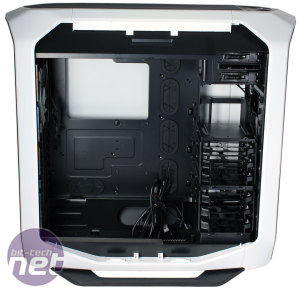

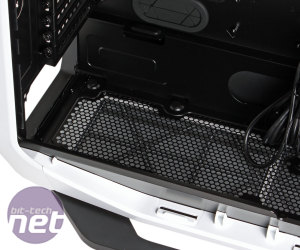
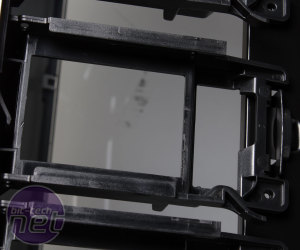
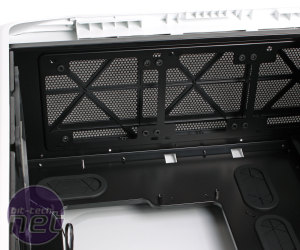
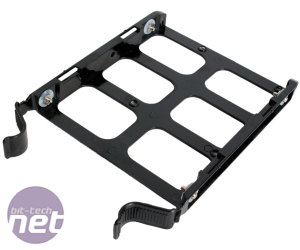

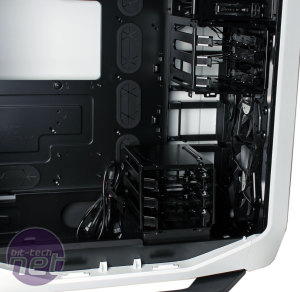







Want to comment? Please log in.